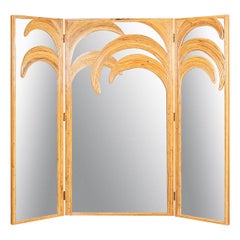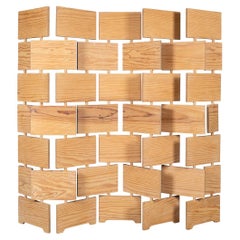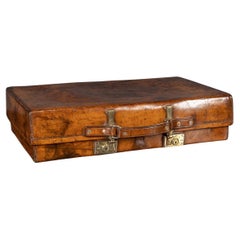Want more images or videos?
Request additional images or videos from the seller
1 of 21
20th Century Middle-Eastern Folding Screen with Enamel Panels
$4,971.03List Price
About the Item
- Dimensions:Height: 78.75 in (200 cm)Width: 70.87 in (180 cm)Depth: 1.58 in (4 cm)
- Materials and Techniques:
- Place of Origin:
- Period:
- Date of Manufacture:20th Century
- Condition:Wear consistent with age and use. Minor fading.
- Seller Location:Royal Tunbridge Wells, GB
- Reference Number:Seller: D71561stDibs: LU1348223973642
About the Seller
5.0
Platinum Seller
Premium sellers with a 4.7+ rating and 24-hour response times
Established in 2014
1stDibs seller since 2015
521 sales on 1stDibs
Typical response time: 1 hour
Authenticity Guarantee
In the unlikely event there’s an issue with an item’s authenticity, contact us within 1 year for a full refund. DetailsMoney-Back Guarantee
If your item is not as described, is damaged in transit, or does not arrive, contact us within 7 days for a full refund. Details24-Hour Cancellation
You have a 24-hour grace period in which to reconsider your purchase, with no questions asked.Vetted Professional Sellers
Our world-class sellers must adhere to strict standards for service and quality, maintaining the integrity of our listings.Price-Match Guarantee
If you find that a seller listed the same item for a lower price elsewhere, we’ll match it.Trusted Global Delivery
Our best-in-class carrier network provides specialized shipping options worldwide, including custom delivery.You May Also Like
19th c. Middle Eastern Filigreed Folding Screen
Located in Queens, NY
Nineteenth century Middle Eastern carved folding screen with three carved teak panels, brass and copper floral designs, and filigreed tops and si...
Category
Antique 19th Century Screens and Room Dividers
Materials
Teak
19th c. Middle Eastern Carved Teak Folding Screen
Located in Queens, NY
Nineteenth century Middle Eastern teak three-fold screen with a spindle and ball design and geometric design bottom panels.
Category
Antique 19th Century Screens and Room Dividers
Materials
Teak
Vintage Middle Eastern 3 Panel Mashrabiya Lattice Folding Screen Room Divider
Located in Philadelphia, PA
Vintage Middle Eastern 3 Panel Mashrabiya Lattice Panel Folding Screen Room Divider. Item features 2 small swing "doors" on the right and left panels, open center (not sure if anythi...
Category
Mid-20th Century Classical Greek Screens and Room Dividers
Materials
Wood
$2,900
H 66 in W 68 in D 1 in
20th Century Chinese Six Panel Folding Screen
Located in New York, NY
This tall Chinese folding screen was made in the 20th Century. It consists of six panels constructed into two parts of three. They are made of a light wood, most likely cypress, with...
Category
20th Century Chinese Screens and Room Dividers
Materials
Wood
20th Century Chinese Six-Panel Folding Screen
Located in New York, NY
This richly designed Chinese folding screen consists of 6 individual panels. It was made in the 2nd quarter of the 20th Century. One side has a black lacquered ground that unfolds a ...
Category
20th Century Asian Screens and Room Dividers
Materials
Wood
Painted Wooden Folding Screen, 5 Panels, 20th Century.
Located in Saint-Ouen, FR
Painted wooden folding screen, 5 panels, 20th century.
Painted wooden folding screen, 5 panels, 20th century.
Centre: H: 128cm, W: 59cm, D: 2.5cm
Sides: H: 128cm, W: 40cm, D: 2,5cm
Category
20th Century French Mid-Century Modern Screens and Room Dividers
Materials
Wood
Early 20th Century Indian Polychrome Four Panel Folding Screen
Located in San Francisco, CA
Early 20th Century Indian Polychrome Four Panel Folding Screen
Category
Early 20th Century Indian Screens and Room Dividers
Materials
Teak
20th Century French Hand Carved Wooden Folding Screen with Three Panels
Located in Sofia, BG
Very massive and heavy wooden folding screen with three panels each one 163 per 51 cm.
France, circa 1950.
Category
Mid-20th Century French Screens and Room Dividers
Materials
Wood
$1,314 Sale Price
55% Off
H 64.18 in W 20.08 in D 1.97 in
Four-Panel Orientalist Screen Depicting Lavish Middle Eastern Interior
Located in Yonkers, NY
A vivid, large-scale screen painted across four hinged wooden panels, this vintage piece presents an ornate and theatrical Orientalist scene with strong visual impact. The composition draws on 19th-century salon painting traditions, depicting a richly appointed Middle Eastern interior and a cast of female figures engaged in ceremonial or domestic ritual. The central focus is a seated woman in lavish patterned robes who receives a cosmetic touch-up from a standing attendant, her ornate headdress already in place. The scene is framed by architectural elements — pointed arches, tiled walls, and elaborate latticework — with a level of stylized detail that adds to the immersive quality.
The palette is rich in golds, crimsons, and deep blues, and the intricate patterns in the rugs, fabrics, and tilework are balanced by more restrained passages of neutral plaster and shadow. Painted directly onto the surface of four tall panels, this screen functions equally well as a folding partition or mounted wall art...
Category
Late 20th Century Chinese Screens and Room Dividers
Materials
Wood
Six-Panel Teak Asian, early 20th Century Folding Screen / Room Divider
Located in Manhasset, NY
Asian 19th Century Folding Screen / Room Divider, Rosewood, Teak, Six Panel
Six-panel rosewood / teak, Asian, Late 19th Century early 20th century. Folding screen / Room divider. A spectacular six panel work of art depicts Chinese glamour at its peak. The finest carvings abound in the manner of love birds perched onto tree bark and branches. The overall case supported by dovetail and mortise tenons. The color of a deep rich patina that only time and age can give to any work. This item was purchased from a Sands Point Long Island mansion along with several other pieces.
Each panel measures 19 inches in width and stands 93.75 inches high. This is an unparalleled piece and is simply stunning in any setting.
The antique room dividers...
Category
Antique 1890s Chinese Export Screens and Room Dividers
Materials
Teak
$22,500
H 93.75 in W 114 in D 1.75 in
More From This Seller
View All20th Century Italian Folding Mirror Screen 'Parma Series' Vivai Del Sud, c.1970
By Vivai del Sud
Located in Royal Tunbridge Wells, Kent
Striking 20th Century Italian mirrored screen from the 'Parma' series, by Vivai del Sud bamboo. This exquisite screen consists of bamboo palm tree motif inlay on a 3-panel mirrored s...
Category
20th Century Italian Floor Mirrors and Full-Length Mirrors
Materials
Bamboo, Mirror
Vintage 20th Century Articulated Pine Wood Screen c.1980
Located in Royal Tunbridge Wells, Kent
A 20th Century articulated pine wood screen, with each panel designed to move, transforming a simple screen into a work of art. An exceptional addition to both modern and classic int...
Category
20th Century British Other Screens and Room Dividers
Materials
Pine
20th Century Oil Painted On Leather Room Screen, c.1920
Located in Royal Tunbridge Wells, Kent
Antique 20th Century beautifully painted four panel dress screen depicting 17th Century battleships at sea. Painted oil on leather, each panel is finished...
Category
20th Century European Screens and Room Dividers
Materials
Leather, Paint
20th Century Revelation Expanding Leather Suitcase, c.1920
Located in Royal Tunbridge Wells, Kent
Antique early 20th Century Bridle Hide Revelation expanding leather suitcase, a hallmark of innovation from the 1920's, showcased a pioneering design that allowed for adjustable stor...
Category
20th Century British Trunks and Luggage
Materials
Brass
20th Century Louis Vuitton Trunk, France c.1930
By Louis Vuitton
Located in Royal Tunbridge Wells, Kent
An exquisite and complete Louis Vuitton trunk from the early part of the 20th century. An absolutely essential item for elite travellers of its time the trunk is adorned in the iconic LV monogrammed canvas, accented by lozine trim and brass fittings. This trunk stood as the epitome of luxury over 100 years ago, boasting an unparalleled level of sophistication and elegance, it remains a timeless masterpiece that transcends eras.
The captivating allure of the Louis Vuitton trunk transforms it into more than a mere luggage accessory; it becomes a focal point for any room. With its impressive dimensions, it is perfectly suited as a striking coffee table, side table, or even as a standalone centrepiece, seamlessly integrating into any interior, whether modern or traditional. An extraordinary piece that not only pays homage to the past but also serves as a statement of unparalleled luxury in the present.
A brief history about Louis Vuitton trunks: Louis Vuitton was born in 1821 to a farmer and milliner and came from a long-established working-class family in eastern France. Vuitton grew up understanding the effects of perseverance and a strong work ethic from watching his family. At the age of 16, he made the decision to walk 292 miles from his hometown to Paris to try and make a new life for himself. When he arrived the city was in the midst of industrialization with current modes of transportation evolving quickly allowing for longer journeys. With this came the need for sturdy travel pieces.
Vuitton was taken as an apprentice for a successful box maker and packer named Monsieur Marechal. He learned to craft durable containers and how to pack them properly – a well-respected profession at the time.In 1854, years after he had mastered his craft and became well respected for it, Vuitton ventured out on his own to open a shop on Rue Neuve des Capucines. It was here that he began to establish himself as a luggage maker. Then, in 1858, Vuitton designed the first Louis Vuitton steamer trunk. At the time trunks had rounded tops to allow for water to run off but this did not allow for convenient stowage. Vuitton introduced a flat, yet waterproof, trunk that was easily stackable. The first of his trunks were outfitted with a grey canvas referred to as Trianon – it wouldn’t be until several decades later that the signature monogram would be introduced.
With a burgeoning business, Vuitton moved his family and workplace to Asniere, where he employed twenty workers to craft his trunks. By 1900 he would have 100 employees, and in 1914 the company would more than double in size. After years of success, Vuitton began to experiment with the design of his luggage by introducing a new striped canvas pattern (1876) and later the still well-known Damier print (1888). The hand-painted patterns were developed to prevent counterfeits. Even in the late 1800s, Louis Vuitton was enough of a status symbol to warrant counterfeiting. In 1886, his son George invented and patented an ingenious locking system that made it impossible to pick the lock of their trunks. This lock is still used today.
1892 would prove to be a time of mourning for the family as Louis Vuitton passed...
Category
20th Century French Other Trunks and Luggage
Materials
Brass
20th Century Louis Vuitton Cabin Trunk, France, c.1910
By Louis Vuitton
Located in Royal Tunbridge Wells, Kent
Around the turn of the 19th and 20th century Louis Vuitton had established himself as a market leader in trunk making and needed to set his...
Category
20th Century French Trunks and Luggage
Materials
Leather, Canvas
Recently Viewed
View AllMore Ways To Browse
Mother Of Pearl Screen
Mother Of Pearl Inlay Screen
Eastern Accents
Mother Of Pearl Room Divider
Mother Of Pearl Dividers
Screen Art Deco French
Antique Chinese Room Dividers
Antique Chinese Screens Room Dividers
Vintage French Screens
Coromandel Screens
Gilded Screen
Large Room Divider
Woven Room Dividers
Sculptural Screen
Metal Folding Screen Room Divider
Painted 4 Panel Screen
Antique Hand Carved Room Dividers
Vintage French Screen Room Divider



